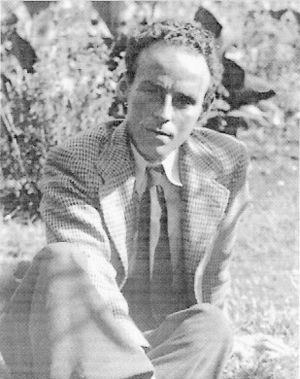César Moro facts for kids
Quick facts for kids
César Moro
|
|
|---|---|
 |
|
| Born | Alfredo Quíspez Asín August 31, 1903 Lima, Peru |
| Died | January 10, 1956 (aged 52) Lima, Peru |
| Occupation | Writer, artist, teacher |
| Period | 20th century |
| Genre | Poetry, essays, painting, collage |
| Literary movement | Surrealism |
| Notable works | La tortuga ecuestre |
César Moro (born Alfredo Quíspez Asín Mas, August 31, 1903 – January 10, 1956) was a talented Peruvian writer and artist. He is best known for his poetry and paintings. Moro wrote most of his poems in French. He was a unique figure in the Surrealist art movement. He was the only Latin American poet featured in important Surrealist magazines by André Breton in the 1920s and 1930s. He was also the first Latin American artist to join the Surrealist group on his own.
Contents
Life and Art Journey
Moving to Paris and Joining Surrealism
César Moro moved to Paris, France, on August 30, 1925. At first, he wanted to be a ballet dancer. Soon after, he decided to focus on creating art and writing poetry.
He had his first art show in Brussels, Belgium, at the Cabinet Maldoror. He showed his work alongside other artists like Santos Balmori and Jaime Colson. While in France, Moro became a big part of the Surrealist art and writing movement. By the 1930s, he was fully involved with the group.
Moro used his writing to speak out against the politics of his time. He wrote for La mobilisation contre la guerre n'est pas la paix (Mobilization Against the War is Not Peace). This was a strong anti-war statement. Moro liked how Surrealism questioned common social ideas and art rules. He used Surrealist art and writing to share his own unique feelings and experiences as an artist in the world.
Around 1926, Moro briefly tried a different painting style called Cubism. He stopped painting scenes from Peru. This change likely happened because people in Paris expected artists from other countries to paint "primitive" or specific national subjects.
Surrealism in South America
Moro returned to Lima, Peru, in 1933. He wanted to become a leader of Surrealism in South America. Other important writers like César Vallejo and José Carlos Mariátegui had already written about Surrealism there.
While in Peru, Moro continued to create art and write. He also started a museum and taught art classes. He even taught art to people with mental illness at Hospital Larco Herrera. In 1935, he helped organize the very first Surrealist art show in South America. He did this with Emilio Adolfo Westphalen at the Academy Alcedo in Lima.
Time in Mexico City
In 1938, Moro had to leave Lima to avoid being arrested. He had published a secret paper supporting the Spanish Republic. Moro moved to Mexico City, Mexico. There, he worked as a cultural ambassador for the French government.
In Mexico, he met many forward-thinking artists. These included Wolfgang Paalen, Alice Rahon, Remedios Varo, and Leonora Carrington. In 1940, Moro organized a big art show called Exposición internacional del surrealismo (International Exposition of Surrealism). It was held at the Galería de Arte Mexicano in Mexico City. Wolfgang Paalen helped him, and André Breton gave advice.
The exhibition featured art from Europe, South America, and the United States. Four of Moro's own artworks were in the international part of the show. These included Pedestrian (1926) and The Art of Reading the Future (1935). In 1944, Moro left the Surrealist movement. He then became close with Mexican artists from a group called Los Contemporáneos. In Mexico, Moro's poems were published in many magazines. His modern and Surrealist writings were shared across the country.
Later Years and Legacy
In 1948, Moro went back to Lima. He taught at the Alianza Francesa and the Colegio Militar Leoncio Prado. He continued teaching until his death in 1956.
After Moro passed away, his friend André Coyné helped save and organize all his works. Coyné was a French poet and art critic.
Selected Works
Here are some of César Moro's important works:
- 1926: Pedestrian (This was used on the cover of the first Surrealist Exposition of South America catalogue.)
- 1943: Le château de grisou
- 1944: Lettre d'amour
- 1954: Trafalgar Square (This book had drawings by Remedios Varo.)
- 1957: La tortuga ecuestre y otros poemas
- 1973: Amour à mort
- 1987: L'ombre du paradisier et autres textes
See also
 In Spanish: César Moro para niños
In Spanish: César Moro para niños

